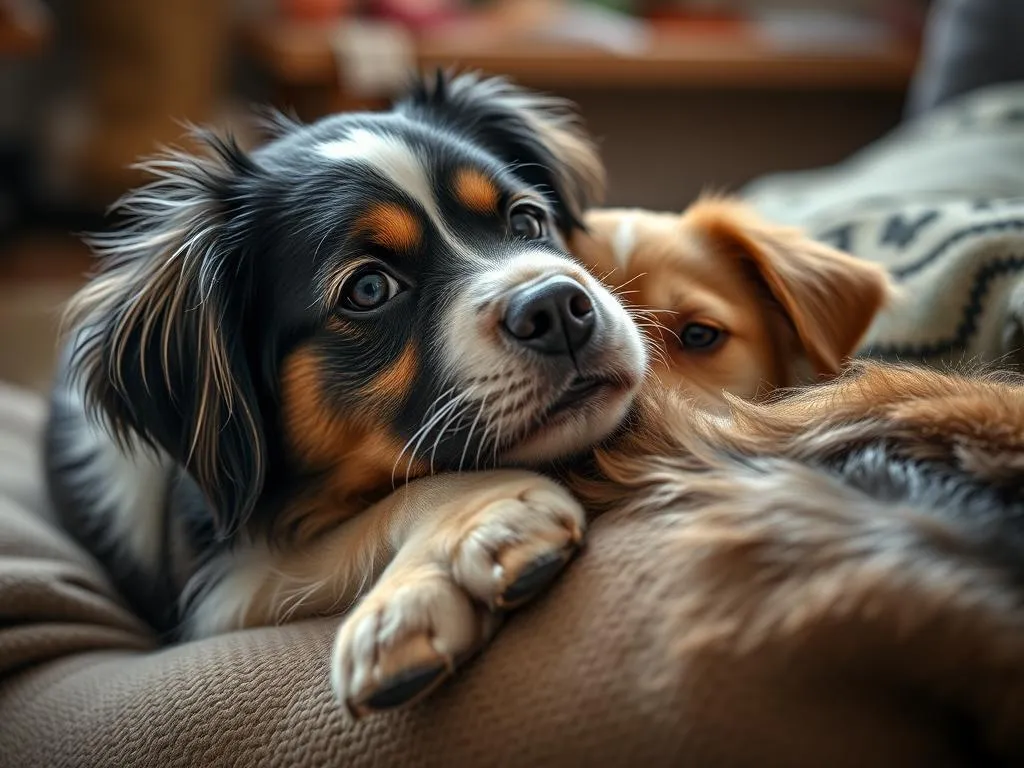
Dogs have been our loyal companions for thousands of years, and their popularity as pets continues to grow. As dog owners, we often find ourselves sharing our beds and sofas with our furry friends, relishing their warmth and affection. Understanding why dogs like to cuddle can deepen our connection with them and enrich our experiences as pet owners. The act of cuddling is more than just a display of affection; it encompasses various emotional and psychological factors that reveal the complexity of canine behavior.
In this article, we’ll explore the nature of cuddling in dogs, the psychological factors that drive this behavior, the benefits for both dogs and their owners, and how different factors can influence a dog’s cuddling tendencies. We’ll also provide tips for encouraging cuddling and debunk common misconceptions.
The Nature of Cuddling in Dogs
Definition of Cuddling
Cuddling in dogs involves close physical contact with their owners or other dogs, often characterized by leaning against someone, nuzzling, or sitting close. Just as humans cuddle to express affection and seek warmth, dogs engage in similar behaviors. They may curl up next to you, rest their head on your lap, or snuggle under a blanket, all of which signify comfort and trust.
Common Cuddling Behaviors
The way dogs cuddle can vary widely based on breed, personality, and individual preferences. Some common cuddling behaviors include:
- Leaning: Dogs often lean against their owners as a way to seek closeness and reassurance.
- Nuzzling: This behavior involves using their nose or face to gently push against their owner, indicating affection.
- Sitting Close: Many dogs prefer to sit right next to their humans, often pressing their bodies against them.
Certain breeds, such as Cavalier King Charles Spaniels and Pugs, are known for their affectionate nature and propensity to cuddle, while others may exhibit different cuddling styles based on their genetic predispositions.
The Psychological Factors Behind Cuddling
Bonding and Affection
One of the primary reasons dogs like to cuddle is to strengthen the bond with their owners. This bond is rooted in the relationship that develops over time through shared experiences, training, and mutual care. When dogs cuddle, they release oxytocin, often referred to as the “love hormone.” This hormone promotes feelings of affection and attachment, reinforcing the connection between dogs and their humans.
Seeking Comfort and Security
Cuddling also provides dogs with a sense of safety and comfort. For many dogs, especially those who have faced traumatic experiences or have been abandoned, close physical contact can be profoundly reassuring. A dog that cuddles may be seeking warmth and the security of their owner’s presence, which creates a safe environment where they can relax.
Understanding Canine Emotions
Dogs possess a remarkable emotional intelligence that allows them to express their feelings through body language and behavior. Cuddling is often a reflection of a dog’s emotional state, whether they are feeling content, anxious, or seeking attention. Recognizing these emotional cues can help owners understand their dogs better and respond to their needs effectively.
The Benefits of Cuddling for Dogs and Owners
Physical Comfort and Warmth
For dogs, cuddling offers physical comfort and warmth, which is essential for their well-being. Dogs have varying thermal needs based on their breed, size, and coat type. Sharing body heat through cuddling can help them stay warm, especially in cooler environments. Physical contact can also soothe aches and pains, providing additional comfort.
Emotional Benefits for Owners
Cuddling with dogs has proven emotional benefits for their owners as well. Research shows that physical touch can significantly reduce stress and anxiety levels. The therapeutic effects of cuddling are amplified by the bond between humans and dogs, creating a sense of companionship and emotional support that can improve overall mental health.
Enhancing the Human-Dog Relationship
Cuddling plays a vital role in enhancing the human-dog relationship. It builds trust and loyalty, making dogs feel valued and secure in their environment. Additionally, cuddling can reinforce positive behaviors and training, as it often serves as a reward or form of praise, strengthening the bond further.
Factors Influencing a Dog’s Cuddling Behavior
Breed Characteristics
Certain breeds are more predisposed to cuddling than others. Breeds known for their affectionate nature, such as Golden Retrievers, Labrador Retrievers, and Dachshunds, often seek close contact with their owners. These breeds have been historically bred for companionship, resulting in a genetic tendency toward affectionate behaviors.
Individual Personality
Just like humans, each dog possesses a unique personality that influences their cuddling preferences. Some dogs are naturally more affectionate and enjoy snuggling, while others may prefer to maintain a bit more distance. Early socialization experiences also play a crucial role in shaping a dog’s personality and their approach to cuddling.
Environment and Lifestyle
The environment in which a dog lives can significantly affect their cuddling behavior. Dogs in urban settings, where they may experience more stimuli and stressors, might seek out cuddling as a way to cope with their surroundings. Conversely, dogs in rural areas with more space may have different cuddling habits based on their lifestyle and the availability of cuddling opportunities from their owners.
Tips for Encouraging Cuddling
Creating a Comfortable Space
To encourage cuddling, it’s essential to create a comfortable and cozy space for your dog. Designate a specific area in your home, such as a soft blanket or a dog bed near you, where they feel safe and comfortable. Adding pillows or their favorite toys can enhance this space, making it even more inviting.
Building Trust with Your Dog
Building a trusting relationship with your dog is crucial for encouraging cuddling. Use positive reinforcement techniques, such as praise and treats, to reward affectionate behavior. Approach your dog gently and avoid sudden movements, as this can help them feel secure and more willing to engage in cuddling.
Recognizing and Respecting Boundaries
Understanding your dog’s boundaries is essential. While many dogs enjoy cuddling, others may prefer their personal space. Pay attention to their body language—if they move away or show signs of discomfort, it’s important to respect their wishes. Always recognize when your dog wants to cuddle versus when they prefer to be left alone.
Common Misconceptions About Dog Cuddling
Cuddling as a Sign of Dominance
A common misconception is that cuddling indicates a dog’s desire to assert dominance. However, this is a misunderstanding of canine behavior. Cuddling is primarily an expression of affection and comfort, not a power play. Dogs that cuddle are often seeking closeness and reassurance from their owners.
Cuddling Only for Affectionate Breeds
Another myth is that only certain breeds enjoy cuddling. While it’s true that some breeds are more predisposed to affectionate behavior, many dogs across various breeds can develop cuddling habits. Individual personality plays a significant role in this behavior, regardless of breed.
Misinterpreting Cuddling as Anxiety
Cuddling is sometimes misinterpreted as a sign of anxiety. While dogs may cuddle to seek comfort during stressful situations, it’s essential to distinguish between cuddling for comfort and signs of anxiety. Observing the context of the cuddling behavior can help owners understand their dogs better.
Conclusion
Understanding why dogs like to cuddle reveals the deep emotional bonds we share with our canine companions. From the psychological factors that drive this behavior to the numerous benefits it provides for both dogs and their owners, cuddling serves as an essential part of the human-dog relationship. Embracing this behavior can foster a stronger connection and enhance your overall experience as a pet owner.
By recognizing the unique needs and preferences of your dog, you can create an environment that encourages cuddling and reinforces your bond. As you cuddle up with your furry friend, remember that this simple act of love is a testament to the cherished relationship you share.









